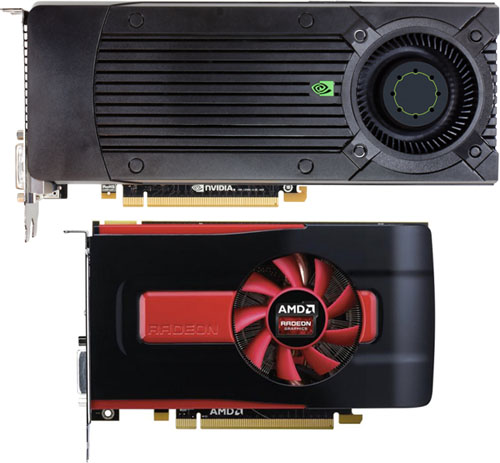- Qualcomm Launches Snapdragon 4 Gen 2 Mobile Platform
- AMD Launches Ryzen PRO 7000 Series Mobile & Desktop Platform
- Intel Launches Sleek Single-Slot Arc Pro A60 Workstation Graphics Card
- NVIDIA Announces Latest Ada Lovelace Additions: GeForce RTX 4060 Ti & RTX 4060
- Maxon Redshift With AMD Radeon GPU Rendering Support Now Available
GIGABYTE Radeon HD 7790 1GB & NVIDIA GeForce GTX 650 Ti BOOST 2GB Review

When there’s a noticeable gap of time in between major GPU launches, one thing’s bound to happen: we’re going to see models get released that slot into gaps we didn’t think existed. That’s the case of both AMD’s Radeon HD 7790 and NVIDIA’s GeForce GTX 650 Ti BOOST, which retail for the same price. Let’s check them out.
Page 8 – Final Thoughts
Sometimes, wrapping-up an article like this is simple. This one is complicated. To help explain why, allow me to quote myself from the intro of my look at NVIDIA’s GTX 650 Ti late last year: “NVIDIA does such a great job filling holes in its product line-ups, that sometimes it manages to fill a void we didn’t even know existed.“
At that time, I couldn’t believe what I was seeing: a brand-new GPU to slot in somewhere I didn’t think it needed to. The gap between the GTX 650 and GTX 660, I felt, was comfortable enough. Adding the GTX 650 Ti to the mix just made a gamer’s purchasing decision all the more difficult. Choice can sometimes be good, but I think there’s a limit to that.
The real reason NVIDIA rolled-out the GTX 650 Ti was to take people’s minds off of AMD’s attractive “Never Settle” campaign it launched a month earlier. This is where competition can sometimes lead us.
While it’d be foolish to state that AMD’s Radeon HD 7790 is a response to NVIDIA’s Titan, it could be from the aspect of AMD’s wanting to turn heads back to its side of the court. After all, free BioShock Infinite? For a $150 GPU, a free $60 game is attractive. NVIDIA has its free-to-play bundle valued at higher, but judging from comments on our site and others, I’ve been able to find few people who have a great interest in it. Had the $75 been claimable for a single title, I think the draw would be far higher.
So yes, what I’m getting at is that neither of these two brand-new GPUs need to exist. As far as I’m concerned, both of them titan up (see what I did there?) a gap that was tight enough. On the upside, more GPUs means more chance to find one at a great price. In this regard, especially on the AMD side, things get weird.

At the moment, you can score an HD 7850 2GB for about $180 with certain vendors (like Sapphire). That’s $10 more than the 7790 2GB model. Unfortunately, due to issues we experienced with our testing motherboard recently, we weren’t able to provide HD 7850 results for this article (the two GPUs featured in this article were tested after the problem (a bad BIOS) was solved). However, based on specs alone, it’s not hard to figure out that $10 for 14% more cores and a move to a 256-bit memory controller is going to be a $10 well-spent. Not to mention, that beefier card also adds Tomb Raider to the free games list. Who on earth would purchase an HD 7790 with all of this being the case?
Onto NVIDIA. The GTX 650 Ti BOOST retails for $170 for a 2GB card, while the GTX 660 can be had for $200. The real-world gains for that upgrade would be about the same as going from an HD 7790 to HD 7850, but the end cost is also higher. As mentioned before, AMD offers a couple of blockbuster games to its bundle, while NVIDIA’s sticking with $75 to split on three separate free-to-play titles (Planetside 2, World of Tanks and HAWKEN).
Between the two cards we took a look at in this article, NVIDIA comes out the clear winner. While part of me believes that the 1GB framebuffer hurt things on AMD’s card (it’s almost baffling that no site was sent a 2GB model), there’s no question that the 128-bit (from 192-bit) memory bus also contributes to the held-back performance. However, since we don’t have access to a 2GB model, it’s hard to say for certain. Personally, a 192-bit bus gives me much more confidence for the future, especially when dealing with the most popular resolution of the moment, 1080p.
If I were in the market right now for a sub-$200 GPU, AMD’s Radeon HD 7850 2GB is what I’d go with. It costs $180, is faster than the HD 7790 and would match the GTX 650 Ti BOOST, and includes two truly fantastic games. The reason to stick with NVIDIA in this event would boil down probably not to its included F2P cash bundle, but whether or not you appreciate features like PhysX.
Make no mistake, both of these two GPUs are attractive in their own right, but with AMD’s HD 7850 offering that costs a mere $10 more and includes two excellent games, it’s pretty hard to draw any other conclusion.
As for GIGABYTE’s variant of the HD 7790, it’s one I’d heartily recommend if you were to go that route. I’ve appreciated the company’s simple-but-effective designs for a while, and as evidenced on the last page, this one has a low power-draw and fantastic temperatures at load. It’s one area in this comparison where AMD came well ahead of NVIDIA.
Support our efforts! With ad revenue at an all-time low for written websites, we're relying more than ever on reader support to help us continue putting so much effort into this type of content. You can support us by becoming a Patron, or by using our Amazon shopping affiliate links listed through our articles. Thanks for your support!





